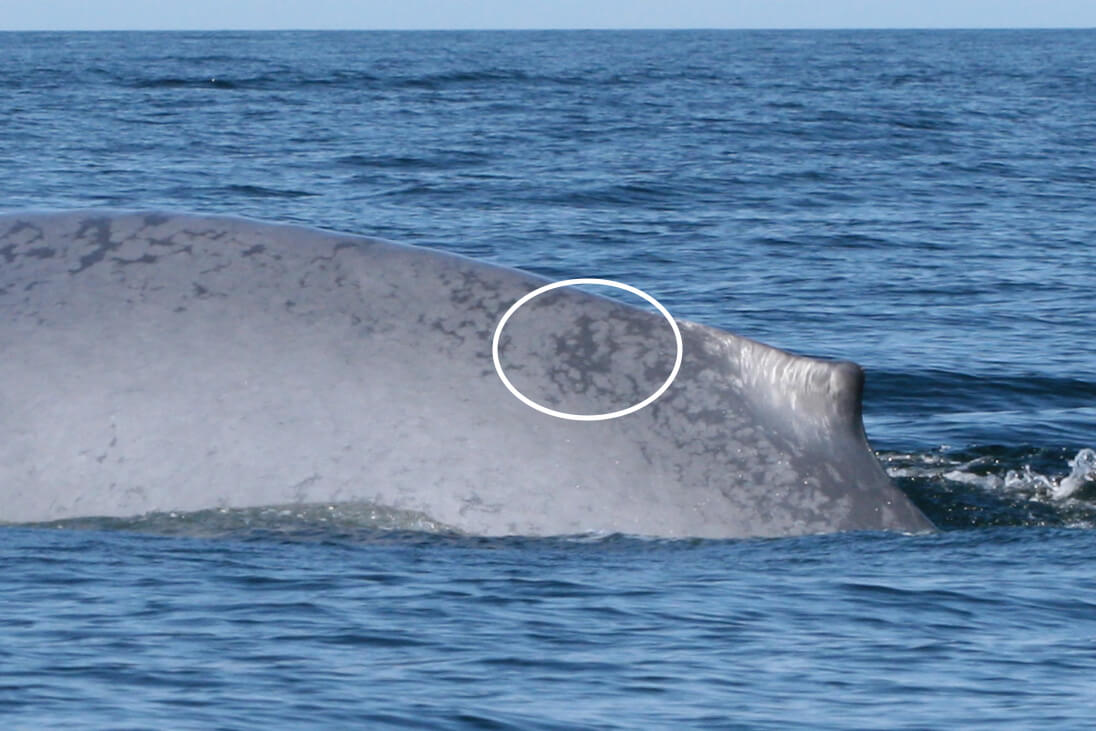The largest animal on Earth – even bigger than the largest dinosaur – the blue whale impresses with its sheer size. Nevertheless, despite their enormity, these animals are still quite difficult to study. With breathing sequences approaching ten minutes and their ability to cover several kilometres in a single dive, blue whales are sometimes spotted just once before they vanish from sight.
On August 10, our collaborator René Roy photographs blue whales off the coasts of Matane and Grosses-Roches. “It was absolutely beautiful out at sea,” he remarks. “Blue whales have been prevalent in this area. The sector must be rich in krill, because I never see minke whales here, which prefer fish.”
Back home, René sifts through his photos. “It’s really with the photos that you realize just how many individuals you’ve seen. Even if we track their breathing sequences, we might actually see a different individual at just about the same place and time that we predicted the first one would resurface.” On this one day alone, he’s tallied a dozen or so individuals, nine of which are well known!
To identify blue whales, researchers and cetacean enthusiasts scrutinize the patterns of greyish-blue spots on the animals’ backs, in addition to sometimes using the shape of the dorsal fin. A minimum of five commonalities are needed to ensure that one has a good “match”.
On August 7, no fewer than three blue whales are swimming off Les Escoumins. Passengers on board a whale-watching cruise don’t seem overly excited when a couple of these gigantic marine mammals are spotted. Is it because they are so far away? The naturalist on board offers an explanation. In the Estuary, at least 400 metres must be maintained between a watercraft – regardless of whether it is a cruise ship or a pleasure craft – and an endangered species such as the beluga or the blue whale.
At this distance, the size of a blue whale might seem a bit underwhelming. Even so, passengers feel privileged to have been able to observe rare blue whales (the Northwest Atlantic population is estimated at less than 250) and happy to comply with the regulation. But when minke whales and humpback whales pop up near the boat, the crowd oohs and ahhs in excitement!
Blue whales can occasionally be observed at close range from shore. On August 8, they are visible from the Cap-de-Bon-Désir Interpretation and Observation Centre in Les Bergeronnes. “We’re having a great summer out on the rocks,” says one naturalist who works there. The day before, four humpbacks and one fin whale came within 500 metres of the sea cliffs. Two days later, the naturalist is able to share her knowledge of three passing fin whales with visitors to the region. “Plus, harbour porpoises and minke whales have been plentiful, too!”
In the Gaspé
These days, observers have all been reporting that Gaspé Bay is relatively quiet in terms of whales. The latter seem to be frequenting the waters off the Forillon cliffs between Cap-des-Rosiers and L’Anse-au-Griffon.
On August 11, a Gaspé woman driving home from Québec City is distracted by several large blasts off Route 132. “I was at the wheel, so I couldn’t look too much, but I couldn’t wait to get home and grab my binoculars!”
Near L’Anse-au-Griffon, one observer is treated to a show on August 9. Two humpbacks slap their tails repeatedly. Then, after this intense activity, the two animals rest at the surface. On August 10, she sees them again. One looks bigger than the other and shows an “X” on its tail. Could it be Tic Tac Toe? No, this famous female was observed the same day in the Saguenay-St. Lawrence Marine Park. So it seems this is a different humpback with an “X” on its tail. In this species, this type of marking is not all that uncommon in tail patterns. Just like with blue whales, one must therefore look for multiple shared features in order to ensure a positive ID.
From Cap-des-Rosiers, an observer enjoys the close swim of twelve fin whales on August 11th. Although fin whales are usually solitary, they will occasionally gather to feed, among other activities. To distinguish fin whales from each other, one must look at the coloration pattern on their flanks. Studying the dorsal fin alone is not enough, as new marks may appear on the dorsal fin.
Where are the whale this week?
This map gives an idea of the presence of whales and does not at all represent the actual distribution of whales in the St. Lawrence. Use it for fun!








